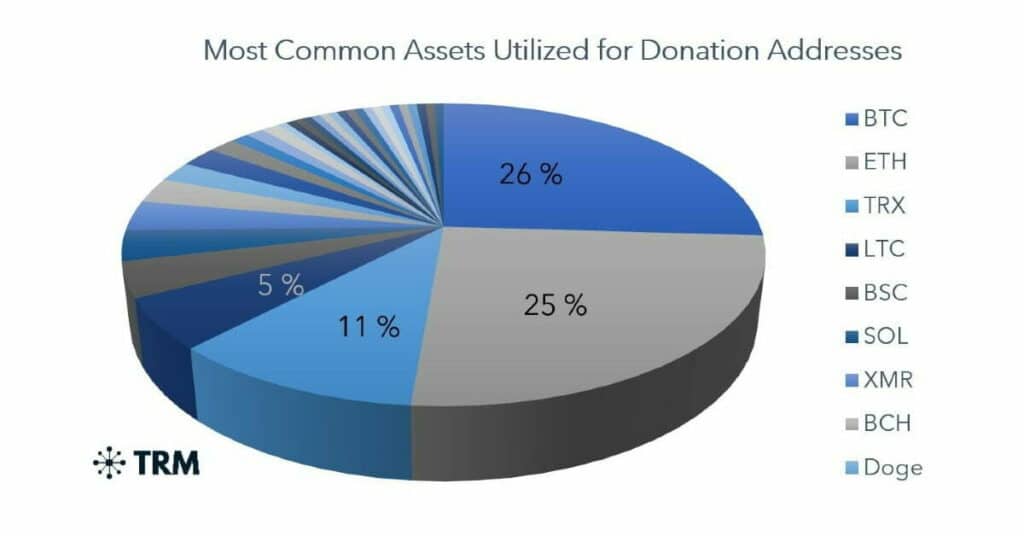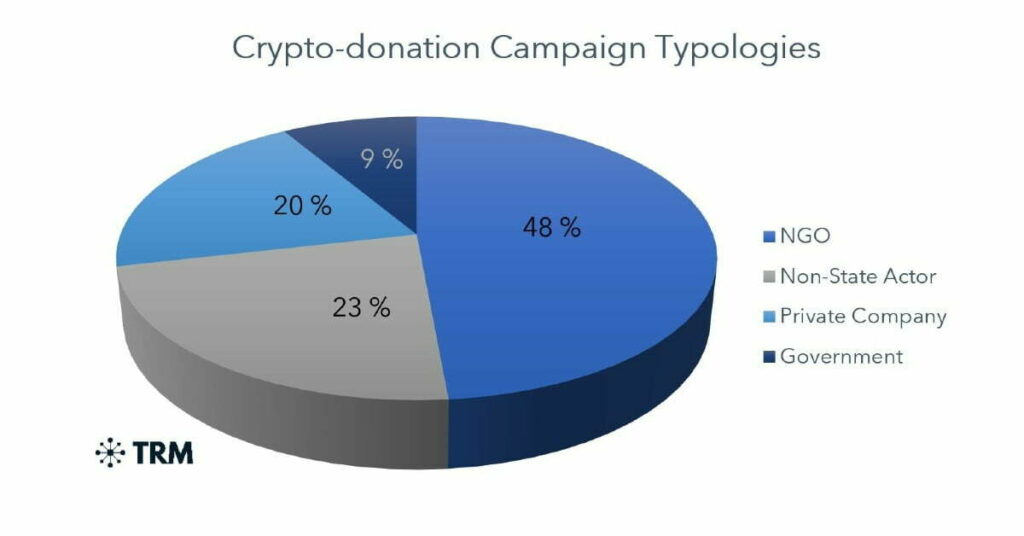Ukraine’s cryptocurrency donation campaigns have shown how the digital currency can play a role in aiding military and humanitarian support during the war. While Elliptic and Chainalysis estimate Ukraine to have received $50M in cryptocurrency donations, a new report from TRM investigators claims the total funding is more than $135.7M.
According to TRM investigators, Ukraine has received more than $135.7M in the form of cryptocurrency between February 22 and March 28. The number is based on an analysis of about 50 crypto-donation campaigns being run to aid Ukraine since the start of Russian invasion on February 24. The investigation also shines light on new approaches to raising funds and dozens of scams.
Ukraine’s cryptocurrency donations in numbers

For its study, TRM investigators analysed about 50 cryptocurrency donation efforts run by official government entities, NGOs, non-state actors, private companies, and even those looking to make quick financial gains in the name of crisis. Based on the data, it has found that a total of $135.7M has been raised so far. Here is a breakup of this donation:
- Official government entities: The cryptocurrency donations were made popular by the Ukrainian government with officials posting wallet addresses for Bitcoin and Ethereum and other coins on Twitter. TRM investigators say the government entities, including Aid for Ukraine, the Cyber Police of Ukraine, and the Ministry of Health of Ukraine, have received $50M inbound donations.
- Non-governmental organisations (NGOs): NGOs such as Come Back Alive and decentralised autonomous organisations such as UkraineDAO combined have received $50M in inbound donations. Their funding has come from multiple chains such as Bitcoin, Ethereum, Tron, and Binance Smart Chain.
- Donations peak: TRM investigators say donations across all campaigns peaked on March 2 with around $30M in inbound donations. While donations have declined since then, the investigators found an average of $500,000 being donated each day.
- Bitcoin and Ethereum are the biggest: Among all donations, over 85 per cent of the cryptocurrency campaigns solicited donations in the form of Bitcoin and Ethereum. The government entities have mostly received Bitcoin and Ethereum despite their embrace of meme coins like Dogecoin. The two leading cryptocurrencies were followed by Tron, Litecoin, and Binance Smart Chain.
Crypto-donation campaigns and diversification
Since Ukraine began accepting donations in the form of cryptocurrency, the crypto-donation campaigns have diversified in two ways. There are actors who have employed blockchain technology to fundraise and then there are organisations adopting technological tactics and a multi-pronged approach to fundraise.
After analysing over 50 crypto-donation campaigns, TRM investigators have reached a conclusion that recent crypto-donation campaigns show how an organisation can launch a successful campaign on social media. The diversification, as mentioned earlier, also extends to platforms and supported assets.

The investigation shows that crypto-donation campaigns are being advertised primarily on Twitter, YouTube, Discord, Telegram, Facebook, and Instagram. However, scammers looking to make financial gains are relying on email campaigns and imitation of legitimate campaigns and websites. The supported assets have extended beyond Bitcoin and Ethereum to support DAOs, launching tokens, and minting NFTs as a means of liquidity.
Massive support from crypto projects @solana @SolanaFndn and @everstake_pool which set up a joint initiative @_AidForUkraine in collaboration with our @mintsyfra to raise funds for @Ukraine.#SOL address:
— Mykhailo Fedorov (@FedorovMykhailo) March 1, 2022
66pJhhESDjdeBBDdkKmxYYd7q6GUggYPWjxpMKNX39KV
One of the standout examples being the Ukrainian Cyber Alliance and other hacktivist groups using crypto-donations to launch cyberattacks against Russian media. Mykhailo Federov, Ukraine’s Vice Prime Minister of Digital Transformation, is leading the government’s crypto funding efforts and even publicised a Solana-based donation address.
Crypto platforms such as EXMO, WhiteBIT/WhitePay, Kuna, and Any.Cash have all launched donation campaigns to support various humanitarian efforts in Ukraine. UkraineDAO and Come Back Alive are the leading NGOs raising funds in the form of cryptocurrency, while non-state actors include hacktivist groups like the Belarusian Cyber-Partisans, and cybersecurity company DisBalancer.
Scam campaigns form half of over 50 crypto-donation campaigns
TRM investigators observe that obvious scam campaigns comprised about half of the over 50 distinct crypto-donations campaigns. These scammers claim to send funds to humanitarian or military efforts but accounted for a small percentage of overall trade volume. The scammers were unable to get away with large amounts of funds because of information coming from government and official sources.
Since authorised government entities, including Ukraine’s Vice Prime Minister Mykhailo Fedorov, directly posting on Twitter, users have been able to find direct campaigns easily. Some of the scam campaigns identified by TRM investigators are Support Ukraine, Ukraine-Fund, Ukraine Embassy Scam, and Ukraine NOW. These scammers were able to raise between a couple of hundred dollars to a couple thousand before they were blocked from such nefarious activity.
How to identify illegitimate donation campaigns
In addition to finding some of the scam campaigns, TRM investigators have also listed some of the potential flags of illegitimate donation campaigns. If you are planning to donate in crypto to Ukraine’s aid then do keep these indicators in mind to find scam campaigns:
- A crypto-donation campaign takes down their domain or deletes Twitter handle hours after launch
- The address of a crypto-donation campaign is flagged on scam alert websites
- A crypto-donation campaign has an unverified Twitter handle
- A crypto-donation campaign receives endorsements from unverified accounts on Twitter
- Large number of new Twitter users following a crypto-donation campaign could hint at suspicious bot activity
- Look for broken links or non-clickable icons for social media accounts on crypto-donation campaigns
There are now over a dozen imitation accounts for UkraineDAO but only the original account has a verified Twitter account. As with any activity on the internet, users and those planning to fund crypto-donation campaigns must vet the presence of the campaign operator before making a donation.










01
From telecom veteran to Dutch Startup Visa success: The Jignesh Dave story